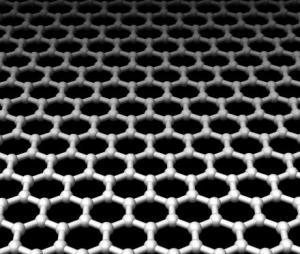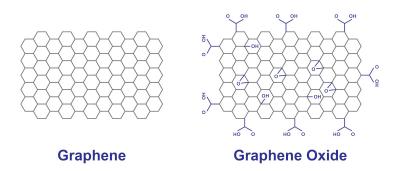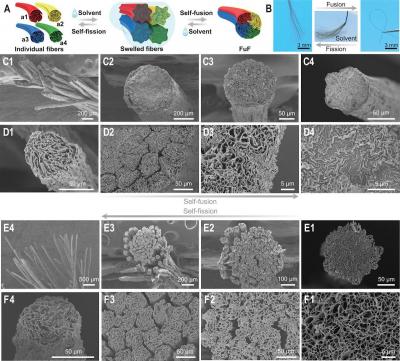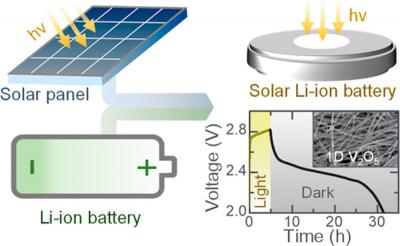What is Graphene Oxide?
Graphene is a material made of carbon atoms that are bonded together in a repeating pattern of hexagons. Graphene is so thin that it is considered two dimensional. Graphene is considered to be the strongest material in the world, as well as one of the most conductive to electricity and heat. Graphene has endless potential applications, in almost every industry (like electronics, medicine, aviation and much more).

As graphene is expensive and relatively hard to produce, great efforts are made to find effective yet inexpensive ways to make and use graphene derivatives or related materials. Graphene oxide (GO) is one of those materials - it is a single-atomic layered material, made by the powerful oxidation of graphite, which is cheap and abundant. Graphene oxide is an oxidized form of graphene, laced with oxygen-containing groups. It is considered easy to process since it is dispersible in water (and other solvents), and it can even be used to make graphene. Graphene oxide is not a good conductor, but processes exist to augment its properties. It is commonly sold in powder form, dispersed, or as a coating on substrates.

Graphene oxide is synthesized using four basic methods: Staudenmaier, Hofmann, Brodie and Hummers. Many variations of these methods exist, with improvements constantly being explored to achieve better results and cheaper processes. The effectiveness of an oxidation process is often evaluated by the carbon/oxygen ratios of the graphene oxide.
Graphene oxide uses
Graphene Oxide films can be deposited on essentially any substrate, and later converted into a conductor. This is why GO is especially fit for use in the production of transparent conductive films, like the ones used for flexible electronics, solar cells, chemical sensors and more. GO is even studied as a tin-oxide (ITO) replacement in batteries and touch screens.
Graphene Oxide has a high surface area, and so it can be fit for use as electrode material for batteries, capacitors and solar cells. Graphene Oxide is cheaper and easier to manufacture than graphene, and so may enter mass production and use sooner.
GO can easily be mixed with different polymers and other materials, and enhance properties of composite materials like tensile strength, elasticity, conductivity and more. In solid form, Graphene Oxide flakes attach one to another to form thin and stable flat structures that can be folded, wrinkled, and stretched. Such Graphene Oxide structures can be used for applications like hydrogen storage, ion conductors and nanofiltration membranes.
Graphene oxide is fluorescent, which makes it especially appropriate for various medical applications. bio-sensing and disease detection, drug-carriers and antibacterial materials are just some of the possibilities GO holds for the biomedical field.
Buy Graphene Oxide
Graphene oxide is relatively affordable and easy to find, with many companies that sell it. It does, however, get confusing since different companies offer products that vary in quality, price, form and more - making the choice of a specific product challenging. If you are interested in buying GO, contact Graphene-Info for advisement on the right GO for your exact needs!
Further reading
The latest graphene oxide news:
Directa Plus says new research supports the use of its graphene nano-materials in COVID face masks
Directa Plus recently stated that a research paper has been published in the journal iScience, supporting the use of its ‘functionalized’ graphene as an antimicrobial material in face masks.
The peer-reviewed paper said the company's G+ nanomaterials and those from graphene oxide provide a critical opportunity to significantly increase face mask efficacy.
Graphene-Info updates all its graphene market report
Today we published new versions of all our graphene market reports. Graphene-Info provides comprehensive niche graphene market reports, and our reports cover everything you need to know about these niche markets. The reports are now updated to July 2021.
The Graphene Batteries Market Report:
- The advantages using graphene batteries
- The different ways graphene can be used in batteries
- Various types of graphene materials
- What's on the market today
- Detailed specifications of some graphene-enhanced anode material
- Personal contact details into most graphene developers
The report package provides a good introduction to the graphene battery - present and future. It includes a list of all graphene companies involved with batteries and gives detailed specifications of some graphene-enhanced anode materials and contact details into most graphene developers. Read more here!
Graphene Flagship Partner SPAC updates on graphene-enhanced automotive components project
SPAC, an Italy-based medium-sized company specializing in the production of technical textiles, has joined the Graphene Flagship's Spearhead Project G+BOARD that aims to build parts of cars’ passenger compartments with graphene and related materials.
G+BOARD’s researchers aim to remove most of the copper wiring currently used in dashboards, to reduce the car’s weight and production steps, while improving aesthetics, disposal and recyclability. SPAC is developing new steering wheels and glove boxes with graphene-based materials.
Sunrise Energy Metals to take full ownership of graphene oxide membrane development joint venture company, NematiQ
In 2018, Sunrise Energy Metals (SRL) and Ionic Industries partnered up and established a JV called NematiQ to develop graphene oxide (GO) membranes for water treatment applications. SRL initially had a 75% stake in the joint venture, before increasing its interest to 83.2% in 2020. Now, SRL announced its plan to take full ownership of NematiQ.
NematiQ has developed a process for manufacturing GO, which can be applied to a membrane support to create a graphene oxide-based nanofiltration membrane (GO-Membrane). The GO-Membrane manufacturing process has reportedly already been demonstrated on commercial-scale industrial equipment.
Researchers demonstrate reversible fusion and fission of graphene oxide–based fibers
Researchers from Zhejiang University, Xi'an Jiaotong University and Monash University have developed a way to bind multiple strands of graphene oxide together, creating a process that could prove useful in manufacturing complex architectures.
 Reversible fusion and fission of GO fibers. Credit: Science
Reversible fusion and fission of GO fibers. Credit: Science
In recent years, materials scientists have been exploring the possibility of making products using total or partial self-assembly as a way to produce them faster or at less cost. In biological systems where two materials self-assemble into a third material, scientists describe this as a fusion process. Accordingly, when a single material spontaneously separates into two or more other materials, they refer to it as a fission process. In this new work, the researchers have developed a technique for creating graphene-oxide-based yarn that exploits both processes.
Graphene oxide gives a boost to new intranasal flu vaccine
Researchers at Georgia State University and Emory University have developed an intranasal influenza vaccine using recombinant hemagglutinin (HA), a protein found on the surface of influenza viruses, as the antigen component of the vaccine.
They also created a two-dimensional nanomaterial (polyethyleneimine-functionalized graphene oxide nanoparticles) and found that it displayed potent adjuvant (immunoenhancing) effects on influenza vaccines delivered intranasally.
Cambridge team designs GO-enhanced light rechargeable Lithium-Ion batteries
University of Cambridge researchers have designed a lithium-ion battery that can be directly charged in sunlight. This was done in an effort to improve the general process of connecting solar panels to batteries to store energy when the sun is shining.

The idea is to simplify how solar energy is harvested and stored, says Michael De Volder, a mechanical engineer at the University of Cambridge who led the work. If the team can improve the efficiency and lifetime of the hybrid device, its cost will likely be lower than combining solar cells and batteries. For the price of a battery, you get both functionalities, he says.
Graphene-Info updates all its graphene market report
Today we published new versions of all our graphene market reports. Graphene-Info provides comprehensive niche graphene market reports, and our reports cover everything you need to know about these niche markets. The reports are now updated to April 2021.
The Graphene Batteries Market Report:
- The advantages using graphene batteries
- The different ways graphene can be used in batteries
- Various types of graphene materials
- What's on the market today
- Detailed specifications of some graphene-enhanced anode material
- Personal contact details into most graphene developers
The report package provides a good introduction to the graphene battery - present and future. It includes a list of all graphene companies involved with batteries and gives detailed specifications of some graphene-enhanced anode materials and contact details into most graphene developers. Read more here!
G6 Materials raises $5 million CAD, to acquire GO application developer GX Technologies
G6 Materials (Formerly called Graphene 3D Lab) has made plans to raise $5 million CAD via a non-brokered offering. The company also announced plans to acquire GX Technologies in an all-share deal (worth around $7.5 million CAD).

GX Technologies is developing applications based on graphene oxide. GXT has a cooperative R&D agreement with the US Army Corps of Engineers to develop graphene oxide-based membranes for use in nanofiltration. The deal with GXT is expected to be closed before April 29, 2021.
Graphene oxide helps achieve efficient air processed perovskite solar cells via scalable technique
A research team, led by Dr. Luigi Angelo Castriotta at the at University of Rome Tor Vergata's CHOSE Center for Hybrid and Organic Solar Energy, has reported impressive results on methylammonium free perovskites processed in air, using a scalable technique based on infrared annealing and potassium doped graphene oxide as an interlayer.
The team reached excellent efficiencies of 18.3% and 16.10% on 0.1cm2 cell and on 16cm2 module respectively, with enhanced stability compared to the standard multi cation reference.
Pagination
- Previous page
- Page 7
- Next page

